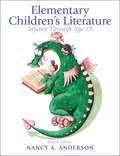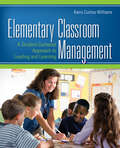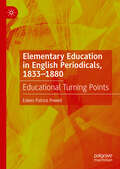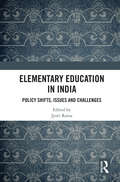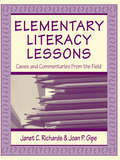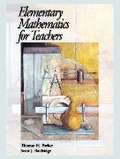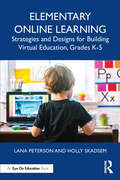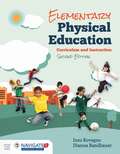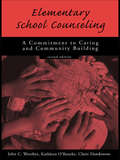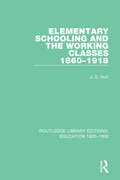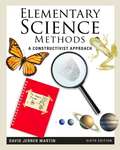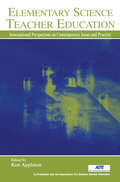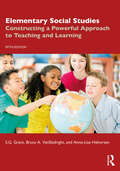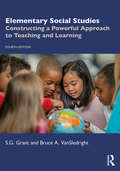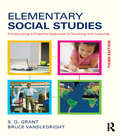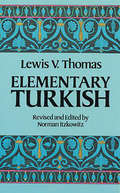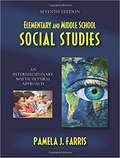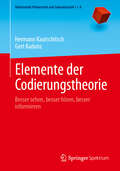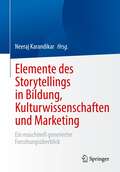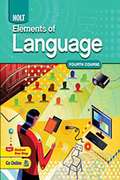- Table View
- List View
Elementary Children's Literature: Infancy Through Age 13
by Nancy A. AndersonThis widely popular book is organized around genres, including a complete chapter on each major genre plus a full chapter for each of the four subgenres of fiction. The teaching strategies, technology applications, coverage of culturally diverse literature, and instructional tie-ins are of immediate use to teachers and parents. Included in each genre chapter are bibliographies of exemplary books in print, multiple annotations, and evaluation criteria for the genre. The author writes in a conversational tone and defines each literary and educational term in the text the first time it is used, and then reinforces the meaning in a useful end-of-book glossary. <P><P> The extensive coverage of culturally diverse literature found throughout the book is supplemented by an excellent chapter (8) on culturally diverse literature written by minority literature specialists who give readers an insider's view of their cultures and provide annotated lists of books by (not just about) minority authors and illustrators. This, coupled with the many instructional ideas woven throughout the book, and the final chapter, "Teaching Reading through Literature," helps teachers and parents apply their knowledge of literature to help children grow in their language and reading abilities.
Elementary Classroom Management: A Student-Centered Approach to Leading and Learning
by Kerry E. WilliamsA student-centered classroom management approach that guides elementary teachers in leading their students and managing the classroom Elementary Classroom Management: A Student-Centered Approach to Leading and Learning provides the information and resources that teachers need to design a classroom management system that incorporates the principles of autonomy, belonging, competency, democracy, and motivation. This text includes stories, strategies, research, and reflection tools to help teachers effectively manage the spaces, procedures, and pedagogy of the classroom environment. Key FeaturesStimulates teachers to reflect on the needs and motivations of their studentsOffers a "right question" rather than a "right answer" approach to help teachers design their own unique classroom management programsProvides real stories, case studies, and letters from master teachers to help readers construct environments that meet the needs of all students Accompanied by High-Quality Ancillaries!An Instructor Resource on CD includes video clips with discussion questions, PowerPoint slides, a test bank, and much more. Qualified instructors can request a copy by contacting SAGE Customer Care at 800-818-SAGE (7243) from 6 am–5 pm, PT.A Student study site at http://www.sagepub.com/kwilliamsstudy provides video clips, quizzes, flashcards, Web resources, and much more.Questions for the author? Contact Kerry Curtiss Williams at kewilli2@wsc.edu
Elementary Education in English Periodicals, 1833-1880: Educational Turning Points
by Edwin Patrick PowellThe nature and purpose of elementary education featured prominently in English periodicals throughout the nineteenth century. This book’s central argument is that the periodical press provided a unique cultural space for literary and intellectual contributions to sustained debates about education. Furthermore, political, economic, social, religious, literary, and cultural developments converged with pivotal educational turning points featured in periodicals that affirmed the creative force of education. However, relatively little scholarly attention has been given to periodicals as a medium for exploring the tension between competing educational ideas and practices in Victorian England. This book therefore reassesses elementary education through the new literary perspectives of periodical culture.
Elementary Education in India: Policy Shifts, Issues and Challenges
by Jyoti RainaThis book examines the policy shifts over the past three decades in the Indian education system. It explores how these shifts have unequivocally established the domination of neoliberal capital in the context of elementary education in India. The chapters in the volume: • Discuss a range of elementary education policies and programs in India with a focus on the policy development in recent decades of neoliberalism. • Analyse policy from diverse perspectives and varied vantage points by scholars, activists, and practitioners, illustrated with contemporary statistics. • Introduce the key curriculum, assessment, and learning debates from contemporary educational discourse. • Integrate the tools and methods of education policy analysis with basic concepts in education, like equality, quantity, equity, quality, and inclusion. A definitive inter-disciplinary work on a key sector in India, this volume will be essential for scholars and researchers of education, public policy, sociology, politics, and South Asian studies.
Elementary Literacy Lessons: Cases and Commentaries From the Field
by Janet C. Richards Joan P. GipeInnovative and practical, this text helps prepare teachers to support the literacy learning needs of all children in grades K-6, including academically, linguistically, and culturally diverse students. It features original teaching cases written by preservice teachers enrolled in field-based reading/language arts methods courses, accompanied by commentaries written by experienced teacher educators and skilled classroom teachers. High-interest content and a reader-friendly format encourage critical and reflective thinking about topics important to effective literacy instruction. By promoting reflection about case issues, the text helps prepare future teachers to respond to teaching narratives presented on the practical applications section of the PRAXIS II, an examination required in most states for teacher licensure. The authentic cases candidly and poignantly describe preservice teachers' plans, problems, hopes, disappointments, dilemmas, and reflective thinking as they address the multilayered complexities and ambiguities associated with learning to teach reading and language arts in elementary classrooms. These teaching stories reveal glimpses of literacy instruction and allow us to enter real classrooms and experience the wide varieties of situations that reading/language arts teachers encounter daily. Although the cases are grouped according to specific dimensions of literacy theory and pedagogy, just as in real classrooms, other issues are woven through each case as well. The commentaries provide scholarly, and sometimes contrasting, perspectives and approaches through which readers might consider the issues presented in the cases. The commentaries represent only particular perspectives, but readers are encouraged to explore and consider as many perspectives and issues as possible regarding each case. Each chapter includes helpfulpedagogical features: * New or critical concepts and terms listed at the beginning of each chapter alert readers to what might be unfamiliar vocabulary. * Applications and Reflections pages help readers take an active part in analyzing, documenting, and talking about the particular issues portrayed in the case narratives. Using the questions on these pages, the cases and accompanying commentaries can be read and discussed as a whole class activity, in small collaborative groups, or by individuals. The questions can also be used by readers to guide their own case writing initiatives. * Margin References direct readers to correlated readings for the strategies and parallel concepts mentioned in the cases and commentaries. Suggested readings can be discussed within the format of literacy study groups. * Annotated Bibliographies at the end of each chapter help readers construct more in-depth knowledge for the instructional strategies and activities discussed in the teaching cases. The cases, commentaries, and pedagogical features in this distinctive text provide rich opportunities for readers to discover what they need to know and how they need to think in order to teach reading and language arts effectively and successfully.
Elementary Mathematics Curriculum Materials: Designs for Student Learning and Teacher Enactment (Research in Mathematics Education)
by Janine T. Remillard Ok-Kyeong KimThe book presents comparative analyses of five elementary mathematics curriculum programs used in the U.S. from three different perspectives: the mathematical emphasis, the pedagogical approaches, and how authors communicate with teachers. These perspectives comprise a framework for examining what curriculum materials are comprised of, what is involved in reading and interpreting them, and how curriculum authors can and do support teachers in this process. Although the focus of the analysis is 5 programs used at a particular point in time, this framework extends beyond these specific programs and illuminates the complexity of curriculum materials and their role in teaching in general. Our analysis of the mathematical emphasis considers how the mathematics content is presented in each program, in terms of sequencing, the nature of mathematical tasks (cognitive demand and ongoing practice), and the way representations are used. Our analysis of the pedagogical approach examines explicit and implicit messages about how students should interact with mathematics, one another, the teacher, and the textbook around these mathematical ideas, as well as the role of the teacher. In order to examine how curriculum authors support teachers, we analyze how they communicate with teachers and what they communicate about, including the underlying mathematics, noticing student thinking, and rationale for design elements. The volume includes a chapter on curriculum design decisions based on interviews with curriculum authors.
Elementary Mathematics for Teachers
by Thomas H. Parker Scott J. BaldridgeA mathematics course for elementary teachers.
Elementary Online Learning: Strategies and Designs for Building Virtual Education, Grades K-5
by Lana Peterson Holly SkadsemElementary Online Learning offers school- and district-level leaders and administrators a field-tested approach to developing formal and interdisciplinary online education, in-house and from scratch, for grades K-5. While it is possible today to purchase off-the-shelf online platforms from for-profit companies, many elementary schools have the option of creating their own programs, curricula, and instructional strategies that are deliberately tailored to the strengths and needs of their own communities. This book provides practical and effective approaches to cohesive, data-driven program design, synchronous and asynchronous teaching, professional development, family partnerships, and much more. Each chapter is full of research-based ideas, recommendations, and prompts that will help schools yield online education that is interdisciplinary, socially just, and student-driven.
Elementary Physical Education
by Inez Rovegno Dianna BandhauerThe Second Edition of Elementary Physical Education translates the most current research on learning, motivation, higher-order thinking skills, and social responsibility into easy to understand concepts and instructional strategies for elementary school physical education. <p><p>The authors have revised, updated, and re-conceptualized the movement approach (skill theme approach) based on findings that have been shown to increase children’s learning and teacher effectiveness. Each content chapter includes sample lesson plans designed to be teaching tools which will help transform the ideas discussed in the book. The content is aligned with the National Standards for Physical Education and NASPE’s guidelines for appropriate practices. <p><p>It offers many sample tools for assessing children's learning and maintaining program accountability. This comprehensive text can be used across several courses including elementary physical education curriculum and instruction, educational gymnastics, educational dance, educational games, and movement foundations courses. It is also the perfect reference tool for field experience courses and student teaching. <p><p>Key Features: <p>• Emphasizes the extensive changes made to the national physical education standards. These new standards have wide support and serve as the major goals for physical education nationwide. <p>• Discussion of the Common Core State Standards which have been adopted by nearly all states and aim for all students to be college and career ready with knowledge and skills that have wide application in adulthood. <p>• With the latest research and findings in the field.
Elementary School Counseling: A Commitment to Caring and Community Building
by John C. Worzbyt Kathleen O'Rourke Claire DandeneauFirst published in 2003. Routledge is an imprint of Taylor & Francis, an informa company.
Elementary School Scheduling: Enhacing Instruction for Student Achievement
by Michael D. Rettig Robert Lynn CanadyThis practical book and its accompanying CD-ROM include over 100 schedules to help elementary schools raise student achievement.
Elementary Schooling and the Working Classes, 1860-1918 (Routledge Library Editions: Education 1800-1926 #8)
by J. S. HurtThis study, first published in 1979, analyses the attitude of various income and occupational groups to elementary schools both before and after the introduction of compulsory school attendance. It also discusses the efforts made by voluntary organisations to provide school meals, as well as examining the quality of the meals themselves, before the enactment of remedial legislation in the early twentieth century. This title will be of interest to students of history and education.
Elementary Science Methods: A Constructivist Approach
by David Jerner MartinIn this pioneering text, a constructivist approach guides users in learning how to teach in a constructivist manner. The book is based on the belief that items more important for children to learn how to do science than it is for them to learn about science, and that teachers of elementary science do not need to know a great deal of science to teach it effectively, but rather need to be co-inquirers with their students. More than 170 process-oriented activities, organized by grade level, help practicing teachers encourage children to develop and perform their own investigations.
Elementary Science Teacher Education: International Perspectives on Contemporary Issues and Practice
by Ken AppletonCo-Published with the Association For Science Teacher Education. Reflecting recent policy and standards initiatives, emerging research agendas, and key innovations, this volume provides a contemporary overview of important developments and issues that have that have in recent years shaped elementary science education pre-service courses and professional development, and practices that are shaping future directions in the field. Contributors from several countries who are actively engaged in research and design in elementary science education address:*Conceptual issues which impinge on contemporary science teacher education;*Intersections of content, pedagogy, and practice; and*Professional development as a contextualized practice.Elementary Science Teacher Education: International Perspectives on Contemporary Issues and Practice offers a clear picture of the current state of the field and directions for the future--to the benefit of elementary science teacher educators, aspiring teacher educators, school policy makers, other professionals involved in science education and, ultimately, the millions of elementary school children who will gain from improved practice.
Elementary Social Studies: Constructing a Powerful Approach to Teaching and Learning
by Bruce A. VanSledright S.G. Grant Anne-Lise HalvorsenThe fully updated fifth edition of Elementary Social Studies provides a rich and ambitious framework to help social studies teachers achieve powerful teaching and learning results. Organized around four commonplaces of education—learners and learning, subject matter, teachers and teaching, and classroom environment—and deeply rooted in inquiry-based teaching and learning, this book deeply probes the basic elements of quality instruction—planning, implementation, and assessment—always with the goal of creating and supporting students who are motivated, engaged, and thoughtful.Book features and updates to the fifth edition include: • New guidance on tackling controversial issues in the social studies classroom. • Fully revised chapter on creating a genuine learning community, which now addresses socio-emotional learning and family involvement in the classroom. • New perspectives on the importance of teaching for social justice. • Increased attention to the C3 Framework for state social studies standards. • Chapters on using the Inquiry Design Model (IDM) to understand inquiry-based teaching and learning and to develop IDM inquiries. • Real-classroom narratives that introduce chapters and provide in-depth access to teaching and learning contexts. • Practical curriculum and resource suggestions for the social studies classroom. • End-of-chapter summaries and annotated teaching resources.By blending the theoretical and the practical, this book is essential reading for pre-service and in-service social studies teachers.
Elementary Social Studies: Constructing a Powerful Approach to Teaching and Learning
by Bruce A. VanSledright S.G. GrantOrganized around four commonplaces of education—learners and learning, subject matter, teachers and teaching, and classroom environment—Elementary Social Studies provides a rich and ambitious framework to help social studies teachers achieve powerful teaching and learning results. By blending the theoretical and the practical, the authors deeply probe the basic elements of quality instruction—planning, implementation, and assessment—always with the goal of creating and supporting students who are motivated, engaged, and thoughtful. Book features and updates to the fourth edition include: • Two new chapters on using the Inquiry Design Model (IDM) to understand inquiry-based teaching and learning and to develop IDM inquiries. • Revised chapter on ideas and questions. • Revised chapter on literacy to more fully incorporate media literacy and digital citizenship. • Real-classroom narratives introduce chapters and provide in-depth access to teaching and learning contexts. • Practical curriculum and resource suggestions for the social studies classroom. • End-of-chapter summaries and annotated teaching resources.
Elementary Social Studies: Constructing a Powerful Approach to Teaching and Learning
by Bruce A. Vansledright S. G. GrantOrganized around four commonplaces of education--learners and learning, subject matter, teachers and teaching, and classroom environment--Elementary Social Studies provides a rich and ambitious framework to help social studies teachers achieve powerful teaching and learning results. By blending the theoretical and the practical, the authors deeply probe the basic elements of quality instruction--planning, implementation, and assessment--always with the goal of creating and supporting students who are motivated, engaged, and thoughtful. Book features and updates to the third edition include: * New chapter on classroom assessment that outlines and compares existing assessment strategies, contextualizes them within the framework of state standards, and articulates a constructivist approach that moves away from traditional high-stakes testing towards more meaningful ways of evaluating student learning * New chapter that highlights and explains key elements of the Common Core State Standards for English Language Arts, and shows how the incorporation of critical ELA instruction into the social studies curriculum can foster more ambitious teaching and learning * Real-classroom narratives that introduce each chapter and provide in-depth access to teaching and learning contexts * Practical curriculum and resource suggestions for the social studies classroom * End-of-chapter summaries and annotated teaching resources
Elementary Statistics: A Student Workbook for an Introduction to Statistics
by J EitelThis is the workbook portion of a course in Elementary Statistics. It is accompanied by web based lecture material. Together they from a course in College Statistics.
Elementary Turkish (Dover Language Guides)
by Lewis ThomasTurkish is the primary language of some thirty million people. Anyone concerned with current social, political, and cultural developments in Turkey knows that a practical understanding of the basic patterns of modern Turkish is an invaluable skill that until now has been difficult to attain without extensive training.This superb grammar and exercise text, used successfully for years in Princeton University, enables English-speaking students — in and out of the classroom — to gain a quick and thorough understanding of modern Turkish. In a carefully arranged sequence of 23 lessons, Lewis V. Thomas, late Professor of Oriental Studies at Princeton, presents thorough coverage that allows the student to begin to use the basic patterns of modern Turkish without time-consuming and expensive private instruction.The method of instruction was devised after an extensive analysis of results in Princeton classrooms, and relies on exercises at the end of each lesson to test the student's grasp of the material. Beginning with the alphabet and numbers, Professor Thomas offers clear, concise coverage of articles, adjectives and nouns, common infinitives, personal pronouns, and elementary verbs. As the student's comprehension of basic elements develops, further lessons deal with more complicated subjects such as the possessive construction, past general verbs, postpositions, the partitive, progressive verb forms, and abbreviating verb forms. A complete Turkish-English glossary translates new vocabulary occurring in the exercises.Norman Itzkowitz, Professor of Near Eastern Studies at Princeton University, has skillfully made the necessary revisions and additions to complete Professor Thomas' work. For anyone who needs to communicate in this important and influential language, Professor Thomas' proven course, now in an inexpensive paperback edition, is the most effective method available.
Elementary and Middle School Mathematics: Teaching Developmentally
by John A. Van de Walle Karen S. Karp Jennifer M. Bay Williams"It is fun to figure out the puzzle of how children go about making sense of mathematics and then how to help teachers help kids. " John A. Van de Walle, Late of Virginia Commonwealth University This is the philosophy behindElementary and Middle School Mathematics: Teaching Developmentally. John A. Van de Walle wrote this book to help students understand mathematics and become confident in their ability to teach the subject to children in kindergarten through eighth grade. Although he could not have foreseen the changes in mathematics teaching over the last three decades, he was at the forefront of the movement towards a constructivist view of teaching, or teaching developmentally. Constructivism says that children construct their own knowledge. They are not blank slates waiting to absorb whatever the teacher tells them. Teachers must understand both mathematics itself and how students learn mathematics in order to teach it effectively. Learning through problem solving is another major theme of this book. Students solve problems not just to apply mathematics, but also to learn new mathematics. Effective problems will take into account where students are, the problematic or engaging aspect of the problem must be due to the mathematics that the students are to learn and not be diluted by non-mathematical activities such as cutting or pasting, and the problem must require justifications and explanations for answers and methods. Learning then becomes an outcome of the problem solving process. The book also addresses in more detail than any other book on the market the effect that the trends of standards-based education, increased pressure to test, and increased teacher accountability have had on teaching mathematics. He addresses the 2000 NCTM Standards in depth, in Chapter 1 on Teaching Mathematics in the Era of the NCTM Standards, through the NCTM icon that appears in the margins throughout the text, and in two appendices in the back of the book. Chapter 5 on Building Assessment into Instruction has also been heavily revised to focus on increased testing pressure, creating more explicit links between objectives and assessment, and including assessments for students with special needs. Elementary and Middle School Mathematics: Teaching Developmentallyis a book for doing math today-for both students who want to become teachers, and the students they will eventually teach. New To This Edition: NEW! Revises Chapter 5 on assessment--Discusses increased testing pressure and accountability, adds more information on equitable assessments, creates more explicit links between objectives and assessment, and includes assessments for students with special needs. NEW! Updates theLiterature Connectionsfeature to remove all out of print children's literature and include more non-fiction, poetry, and other types of readings. NEW! Weaves theFocal Pointsthroughout the chapters as well as links them with theBig Ideasfeature-Focal Pointshave also been added to the Appendix. NEW! Includes expanded coverage of working with diverse learners. NEW! Gives greater emphasis on dealing with math anxiety.
Elementary and Middle School Social Studies: An Interdisciplinary, Multicultural Approach
by Pamela J. FarrisThe latest edition of Pamela Farris's popular, value-priced text continues to offer pre- and in-service teachers creative strategies and proven techniques sensitive to the needs of all elementary and middle school learners. Coverage includes the C3 Framework and the four sets of learning from the National Curriculum Standards for Social Studies. Farris, together with contributors who specialize in implementing successful teaching methods and theories, demonstrate how classroom teachers can excite and inspire their students to be engaged learners.
Elemente der Codierungstheorie: Besser sehen, besser hören, besser informieren (Mathematik Primarstufe und Sekundarstufe I + II)
by Gert Kadunz Hermann KautschitschIm täglichen Leben sind wir zunehmend von Codes umgeben, die mathematisch konstruiert werden. Sie sind teils leicht erkennbar (Strichcode, ISBN, IBAN, QR) und teils eher verborgen (GPS, WLAN, CD, DVD). In diesem Buch werden solche Codes vorgestellt. Es wird dargelegt, wie sie aufgebaut sind, wie sie funktionieren und welche Mathematik zu ihrer Entwicklung und Anwendung notwendig ist. Die Lesenden lernen, eigenhändig Codes zu erstellen, Fehler zu erkennen und zu korrigieren:EAN, ISBN und deren Barcodedarstellung sowie die internationale Bankkontonummer IBAN werden erarbeitet.Kleine QR-Codes werden mit den vorgestellten Methoden (Paritätsprüfung, Linearcode, Polynomcode, zyklischer Code und Reed-Solomon Code) anschaulich realisiert.An der Herstellung einer Mini-CD mit einem CIRC-Code über einem kleinen Körper werden wesentliche Konstruktionsprinzipien von neuen Codes aus bestehenden Codes, wie z.B. Kürzen, Erweitern, Spreizen (Interleaving) und gekreuztes Spreizen (Cross-Interleaving) veranschaulicht.Das Verstehen von Mathematik wird durch diese selbstständige Erstellung und Verwendung didaktisch maßgeschneiderter Codes wesentlich gefördert.Ein besonderer Fokus des Buchs liegt auf elementaren Methoden des Rechnens mit ganzen Zahlen und Polynomen. Für diese benötigt man nur den Satz von der Division mit Rest als zentrale Aussage – daher können große Abschnitte bereits mit Lernenden der Sekundarstufe II erarbeitet und die Grundlagen wesentlicher Teile der Codierungstheorie von den Lernenden mathematisch korrekt erfasst werden. Für Ausführungen, zu deren Verständnis Kenntnisse notwendig sind, die über die Mathematik der Sekundarstufe II hinausgehen, liegt ein ausführlicher Anhang vor (Vektorräume, Matrizen, Rechnen in endlichen Körpern).
Elemente des Storytellings in Bildung, Kulturwissenschaften und Marketing: Ein maschinell generierter Forschungsüberblick
by Neeraj KarandikarDieses Buch ist ein maschinell generierter Überblick über den Einsatz von Storytelling-Elementen in den Bereichen Bildung, Kultur und Marketing. Das Buch gibt einen Einblick, wie sich das Erzählen von Geschichten mit verschiedenen menschlichen Aktivitäten überschneidet und diese beeinflusst. Diese AI-gestützte Zusammenstellung von Forschungsarbeiten ist eine nützliche Ressource für alle Leser, die sich für die Interaktion von Storytelling mit den oben genannten Themen interessieren.
Elements Of Language: Grammar, Usage and Mechanics - Language Skills Practice for Chapters 10-26
by Holt Rinehart Winston StaffMost of the worksheets you will find in this workbook are traditional worksheets providing practice and reinforcement activities on every rule and on all major instructional topics in the grammar, usage, and mechanics chapters in Elements of Language.
